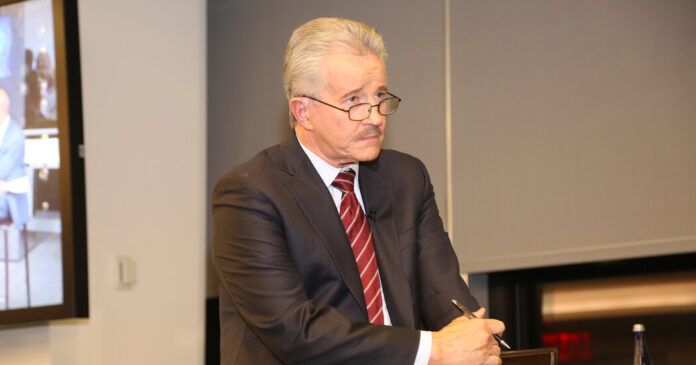Max Gomez, an award-winning medical and science journalist who delivered informed reports for more than 40 years on TV stations in New York and Philadelphia, most recently during the Covid-19 pandemic, died on Sept. 2 at his home in Manhattan. He was 72.
His partner, Amy Levin, said the cause was head and neck cancer, with which he had been diagnosed four years ago.
Billed as “Dr. Max,” he brought an easygoing gravitas to reporting on subjects like vaccinations, knee replacements, prostate cancer, colonoscopies, sickle cell anemia and, when he himself contracted them, Lyme disease and the MRSA infection. One of his reports on Alzheimer’s disease focused on his father, a physician, who was swindled as his memory abandoned him.
Dr. Gomez had been chief medical correspondent at WCBS, Channel 2, in New York City since 2007 and made his last appearance there in March 2022. He also worked at WNBC, Channel 4, and WNEW, Channel 5 (now WNYW), as well as KYW, Channel 3, in Philadelphia.
“What he did best was to care deeply and combine that with being able to explain complex things so well that regular folks could understand them,” Dan Forman, a former managing editor of the Channel 2 news department, said by phone. “And he would activate it by helping viewers find the help they needed.”
Dr. Gomez won seven local Emmy Awards in New York and two in Philadelphia, and some of his work was seen nationally, on the CBS News program “48 Hours” and on NBC News. He was also a semifinalist in NASA’s journalist-in-space program, which was suspended indefinitely after the shuttle Challenger exploded in 1986, and a co-author of three books, among them “Cells Are the New Cure: The Cutting-Edge Medical Breakthroughs That Are Transforming Our Health” (2017, with Dr. Robin L. Smith).
He was a regular presence on Channel 2 from the start of the pandemic, when there were very few diagnosed Covid cases in the United States. For two years, as he dealt with cancer, he explained the medical issues facing viewers; showed how the coronavirus mutates; and sorted through infection data and studies.
He was not a medical doctor — he had a doctorate in neuroscience — and he and the stations where he worked were sometimes criticized for referring to him as Dr. Max Gomez. “Max doesn’t tell people he’s an M.D., nor do we,” Paula Walker, then an assistant news director at Channel 4, told The Philadelphia Inquirer in 1991. “In our estimation, he’s probably more informed than the average health reporter.”
Maximo Marcelino Gomez III was born on Aug. 9, 1951, in Havana and moved to Miami with his family three years later. His father was an obstetrician and gynecologist; his mother, Concepción (Nespral) Gomez, worked for Cubana Airlines, Cuba’s national carrier, and later for Avianca, the largest airline in Colombia.
After graduating from Princeton University in 1973 with a bachelor’s degree in geosciences, Dr. Gomez earned a Ph.D. in neuroscience from the Wake Forest University School of Medicine in 1978. He then became a National Institutes of Health postdoctoral fellow at Rockefeller University in Manhattan.
While studying there, he chose not to pursue a career in research or academia, but rather to look for work in the media that would make use of his scientific background.
“When I first decided to go after television, it was because I thought that if I didn’t, 20 years from now I’d be saying, ‘What if?’” he told The Philadelphia Daily News in 1985.
He added: “Why television? Well, if I said money and ego aren’t part of it, then I’d be lying to you or to myself.”
He contacted Mark Monsky, the news director of Channel 5’s “10 O’Clock News,” who gave him a one-month tryout in July 1980 that turned into a four-year stay. While there, Dr. Gomez was one of the first television reporters to focus on the AIDS crisis, according to Ms. Levin, who was then a producer at the station.
Dr. Gomez moved to KYW in late 1984 and stayed there for six years. While there, he received an award from United Press International for his documentary on AIDS. He later received an award from New York City’s health department for his coverage of the 9/11 attacks while he was working for Channel 4.
“Fear and anxiety levels were out of control in the city, but we were spending the first 20 minutes of every broadcast scaring the living daylights out of people,” he said in an interview in 2016 for the newsletter of CaringKind, an nonprofit Alzheimer’s caregiving organization, “and then, as my news director said, at the end of the show, I had 90 seconds to talk them off the ledge.”
He moved to Channel 2 in 1994 and returned to Channel 4 in 1997 where, after nearly a decade, he was let go when the station cut costs. He came back to Channel 2 in 2007.
In addition to Ms. Levin, Dr. Gomez is survived by a daughter, Katie Gomez; a son, Max IV; and a brother, George. His marriage to SuElyn Charnesky ended in divorce.
In the 1985 Philadelphia Daily News interview, Dr. Gomez said that he viewed his role seriously: Being on television, he said, gave him credibility and a major responsibility.
“I feel I owe it to people to be their first filter,” he said. “So if I’m talking about a health cure, I want to know where has this information been published. I present the best product I can. I know that it’s scientifically accurate.”



